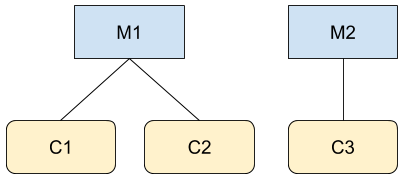CustomerService の ListAccessibleCustomers メソッドを使用してアクセス権を持つお客様を一覧表示できます。ただし、この種類のリクエストでどのお客様が返されるのかを理解する必要があります。
アクセス可能なクライアントを一覧表示することは、Google Ads API ではお客様 ID を指定する必要がない数少ないリクエストのひとつであり、提供された login-customer-id はすべて無視されます。お客様のリストは OAuth 認証情報に基づいて作成されます。このリクエストは、現在の認証情報を提供すると、直接操作できるすべてのアカウントのリストを返します。これには、必ずしもアカウント階層内のすべてのアカウントが含まれるわけではなく、認証されたユーザーがアカウントの管理者などの権利で追加されたアカウントだけを含みます。

ご自身が図の 2 つの階層で M1 と C3 の管理者であるユーザー A であるとします。GoogleAdsService などの Google Ads API への呼び出しを行う場合は、M1、C1、C2、C3 のアカウント情報にアクセスできます。ただし、CustomerService.ListAccessibleCustomers を呼び出すと M1 と C3 のみが返されます。これらのみがユーザー A に対して直接的なアクセス権が付与されるアカウントであることがその理由です。
CustomerService.ListAccessibleCustomers メソッドの使用を示すコードの例を以下に示します。
Java
private void runExample(GoogleAdsClient client) { // Optional: Change credentials to use a different refresh token, to retrieve customers // available for a specific user. // // UserCredentials credentials = // UserCredentials.newBuilder() // .setClientId("INSERT_OAUTH_CLIENT_ID") // .setClientSecret("INSERT_OAUTH_CLIENT_SECRET") // .setRefreshToken("INSERT_REFRESH_TOKEN") // .build(); // // client = client.toBuilder().setCredentials(credentials).build(); try (CustomerServiceClient customerService = client.getLatestVersion().createCustomerServiceClient()) { ListAccessibleCustomersResponse response = customerService.listAccessibleCustomers( ListAccessibleCustomersRequest.newBuilder().build()); System.out.printf("Total results: %d%n", response.getResourceNamesCount()); for (String customerResourceName : response.getResourceNamesList()) { System.out.printf("Customer resource name: %s%n", customerResourceName); } } }
C#
public void Run(GoogleAdsClient client) { // Get the CustomerService. CustomerServiceClient customerService = client.GetService(Services.V22.CustomerService); try { // Retrieve the list of customer resources. string[] customerResourceNames = customerService.ListAccessibleCustomers(); // Display the result. foreach (string customerResourceName in customerResourceNames) { Console.WriteLine( $"Found customer with resource name = '{customerResourceName}'."); } } catch (GoogleAdsException e) { Console.WriteLine("Failure:"); Console.WriteLine($"Message: {e.Message}"); Console.WriteLine($"Failure: {e.Failure}"); Console.WriteLine($"Request ID: {e.RequestId}"); throw; } }
PHP
public static function runExample(GoogleAdsClient $googleAdsClient) { $customerServiceClient = $googleAdsClient->getCustomerServiceClient(); // Issues a request for listing all accessible customers. $accessibleCustomers = $customerServiceClient->listAccessibleCustomers(new ListAccessibleCustomersRequest()); print 'Total results: ' . count($accessibleCustomers->getResourceNames()) . PHP_EOL; // Iterates over all accessible customers' resource names and prints them. foreach ($accessibleCustomers->getResourceNames() as $resourceName) { /** @var string $resourceName */ printf("Customer resource name: '%s'%s", $resourceName, PHP_EOL); } }
Python
def main(client: GoogleAdsClient) -> None: customer_service: CustomerServiceClient = client.get_service( "CustomerService" ) accessible_customers: ListAccessibleCustomersResponse = ( customer_service.list_accessible_customers() ) result_total: int = len(accessible_customers.resource_names) print(f"Total results: {result_total}") resource_names: List[str] = accessible_customers.resource_names for resource_name in resource_names: # resource_name is implicitly str print(f'Customer resource name: "{resource_name}"')
Ruby
def list_accessible_customers() # GoogleAdsClient will read a config file from # ENV['HOME']/google_ads_config.rb when called without parameters client = Google::Ads::GoogleAds::GoogleAdsClient.new accessible_customers = client.service.customer.list_accessible_customers().resource_names accessible_customers.each do |resource_name| puts "Customer resource name: #{resource_name}" end end
Perl
sub list_accessible_customers { my ($api_client) = @_; my $list_accessible_customers_response = $api_client->CustomerService()->list_accessible_customers(); printf "Total results: %d.\n", scalar @{$list_accessible_customers_response->{resourceNames}}; foreach my $resource_name (@{$list_accessible_customers_response->{resourceNames}}) { printf "Customer resource name: '%s'.\n", $resource_name; } return 1; }
curl
# Returns the resource names of customers directly accessible by the user # authenticating the call. # # Variables: # API_VERSION, # DEVELOPER_TOKEN, # OAUTH2_ACCESS_TOKEN: # See https://developers.google.com/google-ads/api/rest/auth#request_headers # for details. # curl -f --request GET \ "https://googleads.googleapis.com/v${API_VERSION}/customers:listAccessibleCustomers" \ --header "Content-Type: application/json" \ --header "developer-token: ${DEVELOPER_TOKEN}" \ --header "Authorization: Bearer ${OAUTH2_ACCESS_TOKEN}" \
キャンセルされたアカウントの一覧を表示する
Google Ads API には、クライアント センター(MCC)アカウントで解約されたアカウントを一覧表示する直接的な方法はありません。ただし、次の回避策を使用してこのリストを取得できます。
customer_client_linkリソースを使用してACTIVEリンクのリストを取得し、customer_client_link.client_customerフィールドを使用して顧客のリストを作成します。SELECT customer_client_link.client_customer, customer_client_link.status FROM customer_client_link WHERE customer_client_link.status = ACTIVEcustomer_clientリソースを使用して、ENABLEDアカウントのリストを取得します。SELECT customer_client.id, customer_client.descriptive_name FROM customer_client2 つのリストの差分が、解約されたアカウントのリストになります。

